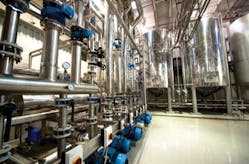The two winners of this year's biggest water prizes in Singapore and Stockholm have brought attention to the world's dwindling phosphorous supplies. A new UK facility could be an alternative to mining this precious material in the future and unlocking wastewater's true value.
Firstly, a huge congratulations to Professor Stephen Carpenter from the University of Wisconsin-Madison in the U.S.. He was the recipient of this year's Stockholm Water Prize, presented during the World Water Week in Stockholm.
During the keynote address in the opening session of the ceremony Carpenter discussed his research on trophic cascades - in essence the impact human activities can have on ecosystems. This led his talk onto the topic of eutrophication and algal blooms, with known consequences of the latter including increased toxicity and oxygen depletion of water supplies.
But it was the topic of phosphorous that grabbed the audience's attention. The professor referred to phosphorous as the "magical element" of algal blooms, blaming high livestock densities. In a stark warning to policy leaders, he said that mined phosphorous capacity could reach severe shortages in as little as 30 years time.
Even Dr James Bernard, the winner of the industry's other lifetime achievement - the Lee Kuan Yew Water prize in Singapore back in July - refers to phosphorous as the "battery of life".
His development of Biological Nutrient Removal technology has helped to reclaim this substance but clearly, these two great minds of the water industry are thinking alike when it comes to raising the profile of this dwindling resource.
Phosphorous is currently mined and controlled by a small number of countries - U.S., China, Morocco, South Africa - but known reserves are running out. Used as a crop fertiliser, it has been linked to environmental damage in agricultural regions when running off into water supplies.
We often hear about the modification of carbon in relation to climate change. Phosphorous, however, doesn't grab as many column inches. Yet it should. Most people when asked would probably be able to tell you that carbon emissions are bad for the environment and exacerbate climate change. Ask these same people about the impact of phosphorous run off into water supplies and you'll likely to be met by blank expressions.
A large number of people will have calculated their carbon footprints, or offset flights, but do they how much phosphorous has been used in getting their food from field to plate? Unlikely. More importantly, would they know how much of this substance can infact be harvested from the waste they flush down the toilet?
Large quantities of nitrogen and phosphorous, when dissolved and combined with magnesium at wastewater facilities, form struvite. It is the resulting struvite scale in pipes, pumps and valves that can cause facility managers a headache. Equipment slowdown and inefficiencies are known effects.
If such nutrients are not recovered from wastewater, yet we continue to spend money mining and shipping raw phosphorous, surely this is counterproductive? And I haven't even mentioned the vast sums of money utilities spend in chemical dosing to clear build ups of struvite in pipes and valves!
For Thames Water in the UK, this has totalled between £130,000 and £200,000 over the course of the year. A partnership with Canadian firm Ostara Nutrient Recovery Technologies aims to change that.
Europe's first phosphorous recovery plant, as it has been referred to, begins operation this year. And 150 tonnes of high-value fertiliser, extracted as crystalline pellets, will be produced every year from the operation. The business model works whereby the utility pays Ostara a monthly fee for the recovery, which is less than the maximum £200,000 it spends on removing struvite.
So, with the utility set to save money, and with raw phosphorous supplies dwindling, we could see more of these plants starting up.
Nor is it with nutrient recovery where the industry is experiencing innovation. As you can read in this issue's regional spotlight on Eastern Europe, Hungary is home to a new breed of inner city, wastewater facilities built to look like a cross between a botanical garden and greenhouse. That's right; you haven't just misread that part: odourless treatment plants placed in the middle of urban environments. Turn to page 28 to read more.
With the Stockholm and Lee Kuan Yew Water Prize winners highlighting the importance of phosphorous recovery, hopefully more investment and time will be ploughed into nutrient recovery. Enjoy the issue and look out for our video interviews from the recent international water events online at www.waterworld.com.
More Water & WasteWater International Current Issue Articles
More Water & WasteWater International Archives Issue Articles




